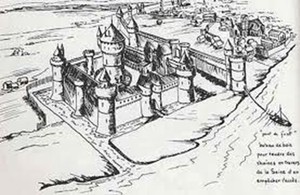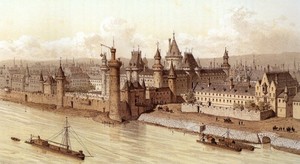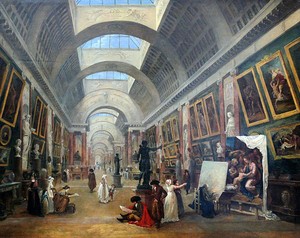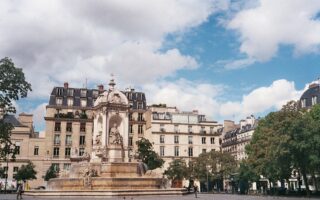The Louvre – Birth of a Museum

- SUBSCRIBE
- ALREADY SUBSCRIBED?
BECOME A BONJOUR PARIS MEMBER
Gain full access to our collection of over 5,000 articles and bring the City of Light into your life. Just 60 USD per year.
Find out why you should become a member here.
Sign in
Fill in your credentials below.

The Louvre at the time of Philippe Auguste (12th Century)
In the Beginning
Difficult to imagine, as we walk through the majestic courtyards and halls of the Louvre today, that 1,000 years ago, all this used to be no more than a small military fortress, its dungeon and high walls intended to dissuade unexpected visitors. Throughout Roman times ïle de la Cité had already remained home to temples and a fortress giving protection when unwanted guests approached from the Seine. In those times most everyone resided in on the south side of Paris – remember the Cluny baths – but, as things became too crowded, they started moving across the river to the north. By the time Philippe II (Philippe Auguste) came to rule in the 12th century, the right bank was a busy place.
In 1189 Pope Gregory VIII called up a third Crusade, one of nine ventures intended to regain and keep the Holy Land. The pilgrims could count on the Knights Templers to protect them. Philippe II was not really enthusiastic about the idea of leaving Paris, but, unable to refuse, he began preparations for the trip. Bishop Maurice de Sully had started building Notre Dame Cathedral in 1163 on the island. Philippe II and his family lived in the Conciergerie, now home to the Paris police and a courthouse where foreigners still go to get their “carte de séjour” or their “carte de travail.”
Since the fall of Rome, things were never really very stable in France, which explains Philippe’s worries about departing for any time, even if the Royal treasure was kept on the right bank, protected by the Templers in their Marais fortress. Just to be safe, before leaving, the King decided to build walls around the Ile de la Cité and add still another fortress with a 31 meter high dungeon surrounded by a moat to protect both his family and the population during his absence. Because the area was known to be popular with wolves (des loups), it is still debated today if wolves actually gave the fortress its name or if, in fact, it came from a word meaning “lower.” In any case the future Louvre was born.
Perhaps it is best that we leave the “intriguing” story of Philippe and England’s Richard the Lionhearted to people like Shakespeare, but we do encourage you to read up on the fascinating adventures and betrayals of our two heroes. Philippe II was devious, Richard was gay and to just what extent the link between our two royal bodies was strictly diplomatic is a “mystery” to this day. In any case they met at Vezelay (a basilica in the Yonne which lays claim to Marie Madeleine’s relics) and, with the blessing of Bernard de Clairvaux , set off to reconquer the Holy Land. Let’s just say that war, power, money and marriage already went hand in hand. With Richard’s “timely” death in 1199, by the time Philippe II passed away in 1223, France had grown from an island in Paris to its present day borders. Louis IX (Saint Louis), the king who built the St Chapelle, went on to transfer the Royal treasure from the Templar’s’ fortress to the Louvre and began building the Louvre’s first real, non defensive rooms. The Louvre was on its way to shedding its rusticity and to becoming a palace of its own.

The Louvre at the time of Charles V (16th Century)
A the time of the Knights Templers
The Marais means swamp in French. When the Knights Templers arrived under Philippe II, they took over the neighbourhood with the king’s blessings, cleaned out the ghastly pestilence, planted trees and built a second palace for themselves rue du Temple that made the King’s palace look insignificant. When the 2,000 Templers, under Jacques de Molay, were arrested by Philippe IV (le Bel) and disbanded in 1307, their incredible wealth was seized. When you have to wage war to keep a kingdom going, it takes money and, when you’ve borrowed it from the Templers, perhaps that’s one way of not having to pay them back. What was left over was given to the future Order of Malte, but not before Philippe IV rebuilt the Conciergerie and moved his part of the confiscated riches to the Louvre along with his arsenal and the State archives. While he was at it, he also deported some 100,000 members of the Jewish community from France and took possession of their property in turn.
Philippe IV (le Bel) was born at the Château de Fontainebleau, spent much of his time with his family there and would die there, falling off a horse, in 1314. When Charles V (le Sage) arrived on the throne in 1364 the Hundred Years War was raging with England. A simple palace, Fontainebleau had nothing to protect it and was abandoned. Charles V continued to use the Conciergerie for impressive ceremonies, but moved his family into the Louvre, greatly improving its comfort at the same time. He also set up a collection of nearly 1,000 books which would later become France’s National Library, the Bibliothèque Nationale.
If François I chose to spend time in Fontainebleau it was for the hunting, but he really lived in the Louvre. With an architect by the name of Lescot, François tore down the dungeon and began transforming the Palace. When the King died, his son Henri II went on with his father’s plans, but it was Catherine de Medici who, with Lescot, actually finished turning the building into the Renaissance Palace it is today. She also added gardens and the 266 meter long Palais des Tuileries where a tile making company had stood until then. The Louvre and the Tuileries Palace were only abandoned when Louis XIV built Versailles in 1682.

Project for arranging the Louvre’s main gallery in 1789, by Hubert Robert
More recently
The various kings, especially from Charles V through François I, were fervent collectors of paintings, but also of spoils from various campaigns. When the French Revolutionary fathers realized that angry crowds were vandalizing and destroying these irreplaceable treasures, they finally began trying to protect them. The Louvre had remained standing under pretext that it was Home to the People. It was decided that everyone, especially poor artists, should get a chance to know its heritage and the Louvre as a museum was born in 1794. Under Napoleon III, still more changes were made. Like the Bastille a century before, both the Tuileries Palace and the Louvre’s north wing would succumb to a fire set by the revolutionary Communards at the height of the Paris Commune in 1871.
The next big changes to the Palace came in the ‘80s when François Mitterrand decided it was time that the Louvre became exclusively a museum. The President of the Republic was above all intent on moving the Ministry of Finance out of the east wing and into that long, bridge-like building you see when you exit Bercy station. Irony, by moving the Ministry, we might say he moved the “Royal Treasure” out of the Louvre! Mostly the former President wanted to get rid of the Ministry’s gloomy parking lot, so today, instead of cars, visitors are greeted by the Pyramid and its fountains. The Louvre’s glass pyramid, like the futuristic Eiffel Tower a hundred years before it, also commemorated the 200th anniversary of the French Revolution. Philippe II’s original Louvre fortress was located in the southwest corner of the Cour Carrée and covered a fourth of the courtyard. Close your eyes. It all began there a thousand years ago.
More in French history, histoire paris, history, Louvre, Museum, Paris art museums, Paris history, Paris museums


